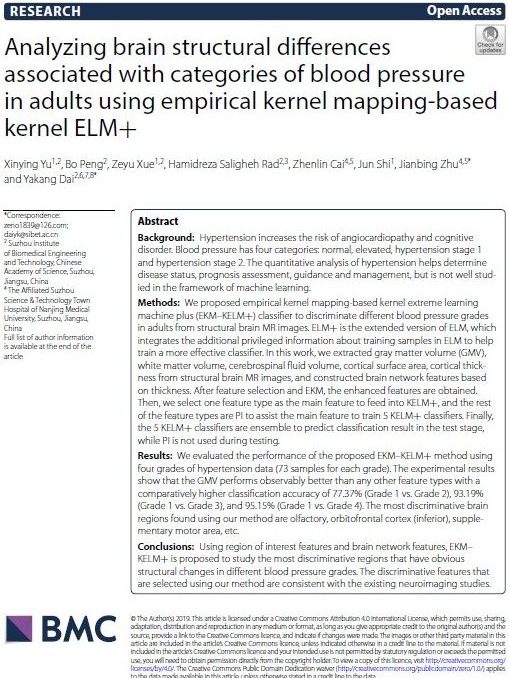Analyzing brain structural differences associated with categories of blood pressure in adults using empirical kernel mapping-based kernel ELM+
Abstract
Background: Hypertension increases the risk of angiocardiopathy and cognitive disorder. Blood pressure has four categories: normal, elevated, hypertension stage 1 and hypertension stage 2. The quantitative analysis of hypertension helps determine disease status, prognosis assessment, guidance and management, but is not well studied in the framework of machine learning.
Methods: We proposed empirical kernel mapping-based kernel extreme learning machine plus (EKM–KELM+) classifier to discriminate different blood pressure grades in adults from structural brain MR images. ELM+ is the extended version of ELM, which integrates the additional privileged information about training samples in ELM to help train a more effective classifier. In this work, we extracted gray matter volume (GMV), white matter volume, cerebrospinal fluid volume, cortical surface area, cortical thickness from structural brain MR images, and constructed brain network features based on thickness. After feature selection and EKM, the enhanced features are obtained. Then, we select one feature type as the main feature to feed into KELM+, and the rest of the feature types are PI to assist the main feature to train 5 KELM+ classifiers. Finally, the 5 KELM+ classifiers are ensemble to predict classification result in the test stage, while PI is not used during testing.
Results: We evaluated the performance of the proposed EKM–KELM+ method using four grades of hypertension data (73 samples for each grade). The experimental results show that the GMV performs observably better than any other feature types with a comparatively higher classification accuracy of 77.37% (Grade 1 vs. Grade 2), 93.19% (Grade 1 vs. Grade 3), and 95.15% (Grade 1 vs. Grade 4). The most discriminative brain regions found using our method are olfactory, orbitofrontal cortex (inferior), supplementary motor area, etc.
Conclusions: Using region of interest features and brain network features, EKM–KELM+ is proposed to study the most discriminative regions that have obvious structural changes in different blood pressure grades. The discriminative features that are selected using our method are consistent with the existing neuroimaging studies. Moreover, our study provides a potential approach to take effective interventions in the early period, when the blood pressure makes minor impacts on the brain structure and function.

